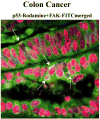Focal adhesion kinase and p53 signal transduction pathways in cancer
- PMID: 20515733
- PMCID: PMC3136041
- DOI: 10.2741/3653
Focal adhesion kinase and p53 signal transduction pathways in cancer
Abstract
Human cancer is characterized by a process of tumor cell motility, invasion, and metastasis. One of the critical tyrosine kinases that is linked to these processes of tumor invasion and survival is the Focal Adhesion Kinase (FAK). Our laboratory was the first to isolate FAK from human tumors, and we had demonstrated that FAK mRNA was up-regulated in invasive and metastatic human breast and colon cancer samples. We have cloned FAK promoter and have found that FAK promoter contains p53 binding sites, and that p53 inhibits FAK transcription and regulates its expression in tumor samples. In addition, we have found a high correlation between FAK overexpression and p53 mutations in 600 population-based series of breast cancer patients. found that N-myc binds FAK promoter and induces FAK transcription in neuroblastoma cells. Thus, this review will be focused on FAK and p53 signal transduction pathways in cancer.
Figures




Similar articles
-
FAK and p53 protein interactions.Anticancer Agents Med Chem. 2011 Sep;11(7):617-9. doi: 10.2174/187152011796817619. Anticancer Agents Med Chem. 2011. PMID: 21355845 Free PMC article. Review.
-
Focal adhesion kinase and p53 signaling in cancer cells.Int Rev Cytol. 2007;263:103-53. doi: 10.1016/S0074-7696(07)63003-4. Int Rev Cytol. 2007. PMID: 17725966 Review.
-
p53 regulates FAK expression in human tumor cells.Mol Carcinog. 2008 May;47(5):373-82. doi: 10.1002/mc.20395. Mol Carcinog. 2008. PMID: 17999388 Free PMC article.
-
FAK and Nanog cross talk with p53 in cancer stem cells.Anticancer Agents Med Chem. 2013 May;13(4):576-80. doi: 10.2174/1871520611313040006. Anticancer Agents Med Chem. 2013. PMID: 22934707 Free PMC article. Review.
-
Focal adhesion kinase versus p53: apoptosis or survival?Sci Signal. 2008 May 20;1(20):pe22. doi: 10.1126/stke.120pe22. Sci Signal. 2008. PMID: 18493017 Free PMC article. Review.
Cited by
-
Identification of hub genes involved in cisplatin resistance in head and neck cancer.J Genet Eng Biotechnol. 2023 Jan 30;21(1):9. doi: 10.1186/s43141-023-00468-y. J Genet Eng Biotechnol. 2023. PMID: 36715825 Free PMC article.
-
Inhibition of cell migration by focal adhesion kinase: Time-dependent difference in integrin-induced signaling between endothelial and hepatoblastoma cells.Int J Mol Med. 2018 May;41(5):2573-2588. doi: 10.3892/ijmm.2018.3512. Epub 2018 Feb 23. Int J Mol Med. 2018. PMID: 29484384 Free PMC article.
-
Targeting angiogenesis and the tumor microenvironment.Surg Oncol Clin N Am. 2013 Oct;22(4):629-39. doi: 10.1016/j.soc.2013.06.002. Epub 2013 Jul 26. Surg Oncol Clin N Am. 2013. PMID: 24012392 Free PMC article. Review.
-
TIAF1 self-aggregation in peritumor capsule formation, spontaneous activation of SMAD-responsive promoter in p53-deficient environment, and cell death.Cell Death Dis. 2012 Apr 26;3(4):e302. doi: 10.1038/cddis.2012.36. Cell Death Dis. 2012. PMID: 22534828 Free PMC article.
-
High FAK combined with low JWA expression: clinical prognostic and predictive role for adjuvant fluorouracil-leucovorin-oxaliplatin treatment in resectable gastric cancer patients.J Gastroenterol. 2013 Sep;48(9):1034-44. doi: 10.1007/s00535-012-0724-7. Epub 2013 Jan 11. J Gastroenterol. 2013. PMID: 23307041
References
-
- Weiner TM, Liu ET, Craven RJ, Cance WG. Expression of focal adhesion kinase gene and invasive cancer. Lancet. 1993;342(8878):1024–1025. - PubMed
-
- Owens LV, Xu L, Craven RJ, Dent GA, Weiner TM, Kornberg L, Liu ET, Cance WG. Overexpression of the focal adhesion kinase (p125FAK) in invasive human tumors. Cancer Research. 1995;55(13):2752–2755. - PubMed
-
- Owens LV, Xu L, Dent GA, Yang X, Sturge GC, Craven RJ, Cance WG. Focal adhesion kinase as a marker of invasive potential in differentiated human thyroid cancer. Annals of Surgical Oncology. 1996;3(1):100–105. - PubMed
-
- Cance WG, Harris JE, Iacocca MV, Roche E, Yang X, Chang J, Simkins S, Xu L. Immunohistochemical analyses of focal adhesion kinase expression in benign and malignant human breast and colon tissues. correlation with preinvasive and invasive phenotypes. Clin Cancer Res. 2000;6(6):2417–2423. - PubMed
Publication types
MeSH terms
Substances
Grants and funding
LinkOut - more resources
Full Text Sources
Other Literature Sources
Molecular Biology Databases
Research Materials
Miscellaneous

